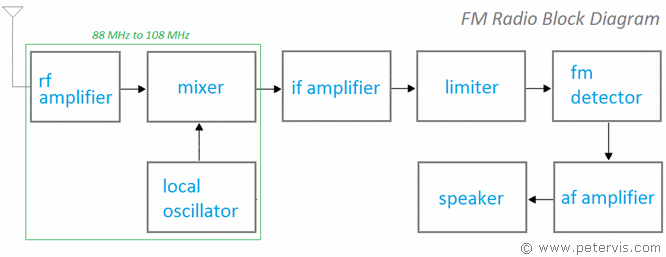FM Radio Block Diagram
This superheterodyne FM radio block diagram shows all the main stages of a modern radio. The first three stages are very similar to an AM radio block diagram; however, the main difference is in the limiter and FM detector stages, which are crucial to FM reception. These stages are responsible for decoding the frequency-modulated signal. In order to understand them, we need to consider the encoding process because the decoding is simply the reverse.
FM Detector Stage
In FM encoding, the amplitude of the carrier wave remains constant, and it is the variation in frequency where information is stored. Specifically, variation in frequency is proportional to the amplitude of the encoding signal. In many ways, you can think of this as amplitude to frequency conversion. When the encoding signal is in the positive phase, the carrier frequency is at maximum, however when it is in the negative phase, the carrier frequency is at minimum. Variation in frequency is proportional to the amplitude of the encoding signal. This way we can represent the level of amplitude in terms of frequency.
In a radio receiver, the FM detector, also known as discriminator, does the opposite because it has to decode the encoded signal. Therefore, the FM detector stage converts variations in frequency to variations in amplitude to recover the original signal. Hence, this is very much a frequency to amplitude converter. In electronics, many IC packages can convert frequency to voltage. This is where the voltage is proportional to frequency.
Limiter Stage
The limiter stage is a very simple IF amplifier that keeps the amplitude of the FM signal to a constant level. It has a built-in gain control circuitry so that the amplitude of the signal remains precisely the same. This is because the FM carrier is just as vulnerable to have its amplitude corrupted as AM is, however, since FM does not store information in the amplitude of the carrier, we can correct any corruptions easily and maintain the amplitude to a constant value.
Radio Designs
In practice, many radios that can receive FM and AM have a shared IF stage, and AF stage. Usually a radio that has FM reception will have a special FM tuner encased in metal shielding. Usually this part contains the oscillator, mixer, and RF stages. If you look at the construction of the Zenith Transoceanic, then it might give more insight.

